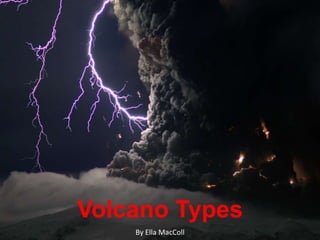
Types of Volcano Revision
- 1. Volcano Types By Ella MacColl
- 2. Hot Spots These are volcanoes which do not form at plate margins but in the middle of plates, such as the chain of volcanic islands in Hawaii in the Pacific. It is thought that these occurred due to a localised hot spot. This interplate volcanic activity is caused by unusually hot mantle material forming in the lower mantle, pushing it’s way into the upper mantle to form a magma plume. This magma plume pushes through the lithosphere above, when the lava breaks through the surface, active volcanoes form. Magma plumes are stationary, so as the plate moves over the top of it, a line of volcanoes is created – such as the Hawaiian Ridge a top the pacific plate. The Volcano above the hot spot is active and the others remain dormant.
- 3. Dome Volcanoes Often occur at destructive plate margins. The lava from dome volcanoes tends to be either rhyolitic or andesitic. CHARACTERISTICS: o Made up of layers of lava o Steep sided - high viscosity lava (flows slowly) Similar to Stratovolcanos – except a stratovolcano has alternating layers of ash and lava.
- 4. Caldera Often occur at destructive margins, where they produce andesitic and rhyolitic lavas. Formed when central part of volcano has collapsed or blasted off as magma chamber has emptied. CHARACTERISTICS: • Very wide circular crater – several kilometres across. Eg. Aira Caldera - Japan
- 5. Shield Volcano Often occur at constructive margins or hotspots. Usually produce basaltic lava. CHARACTERISTICS: • Gentle Sloping Sides – Caused by low viscosity lava (flows over long distances) Eg. Mauna Loa - Hawaii
- 6. Fissure Volcano AKA – Fissure Vent or Volcanic Fissure Occur at constructive margins where plates move apart allowing magma to erupt onto the earths surface. Usually produce basaltic lava. CHARACTERISTICS: • Fairly flat surface – Low viscosity lava (flows over long distances) • Long linear vent – can be a few metres wide but several kilometres long Eg. Laki- Iceland
